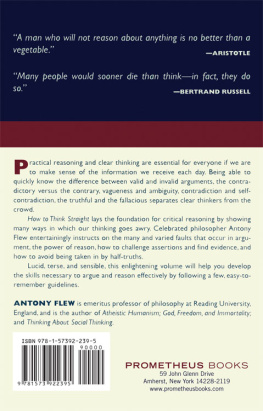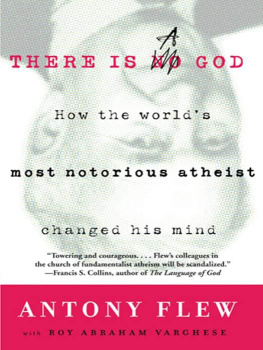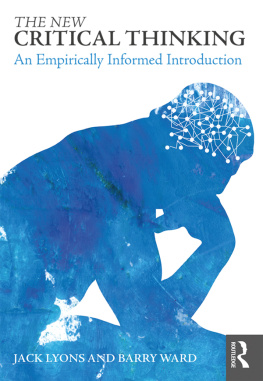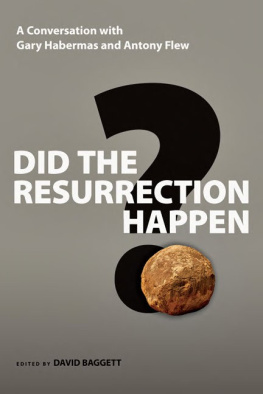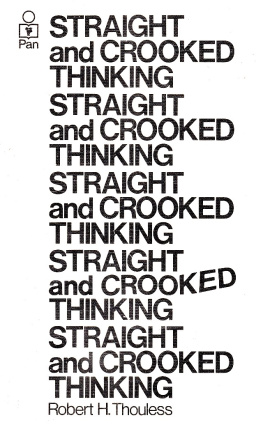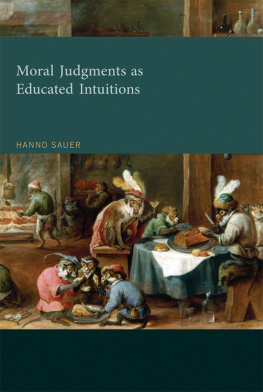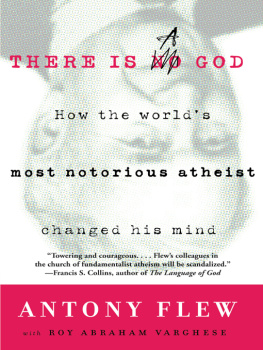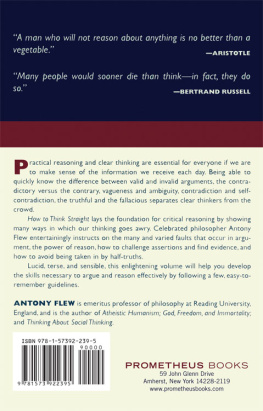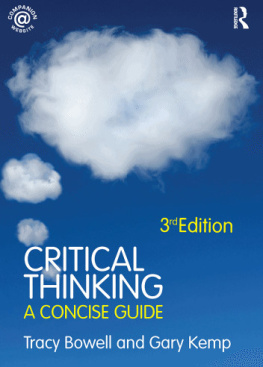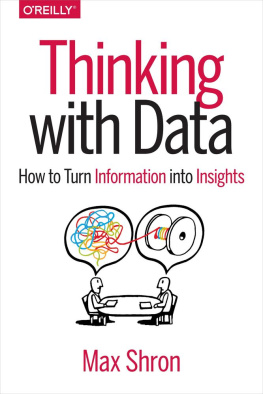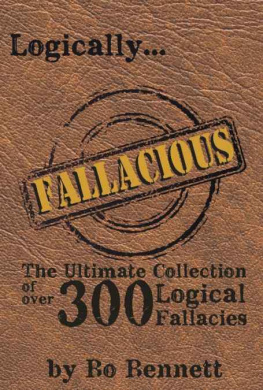Published 1998 by Prometheus Books
How to Think Straight: An Introduction to Critical Reasoning. Copyright 1998 by Antony Flew. All rights reserved. No part of this publication may be reproduced, stored in a retrieval system, or transmitted in any form or by any means, digital, electronic, mechanical, photocopying, recording, or otherwise, or conveyed via the Internet or a Web site without prior written permission of the publisher, except in the case of brief quotations embodied in critical articles and reviews.
Inquiries should be addressed to
Prometheus Books
59 John Glenn Drive
Amherst, New York 142282197
VOICE: 7166910133, ext. 207
FAX: 7165642711
WWW.PROMETHEUSBOOKS.COM
06 05 04 03 02 8 7 6 5 4
The Library of Congress has cataloged the printed edition as follows:
Flew, Antony.
[Thinking about thinking]
How to think straight : an introduction to critical reasoning / by Antony Flew.
p. cm.
Originally published: Thinking about thinking.
Includes bibliographical references and index.
ISBN 1573922390 (alk. paper)
ISBN 978-1-57392-239-5 (pbk.)
ISBN 978-1-61592-215-4 (ebook)
1. Thought and thinking. I. Title.
BF455.F614 1998
160dc21
988517
CIP
Printed in the United States of America on acid-free paper
We must follow the argument wherever it leads.
Socrates (Fifth Century B.C.E.)
A man who will not reason about anything is no better than a vegetable.
Aristotle (Fourth Century B.C.E.)
A moments thought would have shown him. But a moment is a long time, and thought is a painful process.
A. E. Housman (Twentieth Century C.E.)
Many people would sooner die than thinkin fact, they do so.
Bertrand Russell (Twentieth Century C.E.)


The present work is a revised and greatly expanded version of a book originally published in the United Kingdom as Thinking about Thinking and later reissued in the United States of America as Thinking Straight. The revision is primarily an update of the original work. References to controversies since deceased have been replaced by others more topical. But there has also been some simplification, intended to make the contents easier for readers to master. The purpose of the expansion was to introduce additional useful material, especially material relevant to what have become major controversial issues since the appearance of the first edition. Among these are, for instance, controversies about pollution, conservation, and the proportionate representation of various perceived minorities in different areas of activity and achievement.
Among members of the class of books aimed at the improvement of the quality of thinking, Thinking Straight was from the beginning distinctive in two ways. One was the frequency of references to the ideas both of various classical philosophers and of other major thinkers such as Karl Marx. I have been told by colleagues who have used Thinking Straight as the required text for critical thinking courses that these references have led some of their pupils to sign up for further courses in departments of philosophy. This has encouraged me to introduce into this second edition both paragraph-long quotations from Ren Descartes and David Hume and other equally relevant, shorter quotations from Thomas Aquinas, John Locke, Thomas Hobbes, and, again, David Hume. I have also introduced parenthetic references to various books with which those seriously engaging in these current controversies need somehow to come to terms. That, as was made very clear in the frequent use of that expression by Karl Marx, is by no means the same as coming to agree!
The second distinctive feature of Thinking Straight is indicated by the subtitle given to the first edition. It was: Or, Do I Sincerely Want to Be Right? Other books about critical thinking at least tend to suggest to their readers that the authors chief concern is helping readers protect themselves against deception by unsound arguments urged, whether innocently or intentionally, by other people. Certainly this is necessary work. But it is not sufficient. A prime cause of our being deceived is, for all of us, always our own desire to be so deceived. How to Think Straight: An Introduction to Critical Reasoning therefore insists throughout that all of us constantly need to be asking ourselves what it is which we want to believe to be true, and whether our desires so to believe are stronger than our desires to know the truth, however uncongenial to us that truth may be. It is a truly existential challenge.
Antony Flew
26 Alexandra Road
Reading RG1 5PD
England

1.1 The first thing to get straight in thinking about thinking is the difference between questions about validity and questions about truth. But in getting this straight we shall find that we are also sorting out every other really fundamental notion. For the indispensable notions are all connected. We cannot fully master any one without getting the same grasp upon the lot. Once the essential preparation is complete, we may proceed to the main business of the book. That business is to consider examples of thinking, usually of bad thinking, in order to learn how to do the job better. Here and now we have first to clean and tidy the tools.
1.2 The reason to begin precisely where we are beginning is that thinking about thinking is concerned, at least in the first instance, with the validity or invalidity of arguments, rather than with the truth or falsity of propositions. What is true, or false, is propositions. What is valid, or invalid, is arguments. These notions and these distinctions are absolutely basic. To say that an argument is true or that a proposition is valid is as uncomprehending or as inept as to say that someone got to first base in basketball or that someone made a home run in tennis.
1.3 Consider propositions. There are, of course, propositions and propositions. Both those mutually advantageous proposals which one businessman makes to another and those improper but delightful suggestions which playboys put to their intended playmates are called, quite properly, propositions. But in this bookperhaps regrettablywe shall engage with propositions only in a quite different sense of the word. In this, our relevant sense, the word proposition is defined as, whatever may be asserted or denied. So a proposition for us becomes whatever may be expressed by the that-clause in such sentences as, She asserted that he had been there on Wednesday, or He denied that he had ever met her.
1.4 In the irrelevant, proposal sense a proposition may be said to be attractive or unattractive, profitable or unprofitable, and many other things besides. What it cannot be, or be said to be, is either valid or invalid. In our different sense there are again several things which a proposition may be: demonstrated, for instance, or probable, or refuted. Nevertheless, the primary characteristic is truth or falsity. For demonstration here is nothing else but proving that the proposition is true. The proposition which is probable just is probably true. Refutation, again, is not merely saying, but showing, that the proposition is false. It is because refutation involves more than denial that hard-pressed spokespersons so often assert that they have refuted charges when in fact all that they have done is deny them, perhaps dishonestly.

